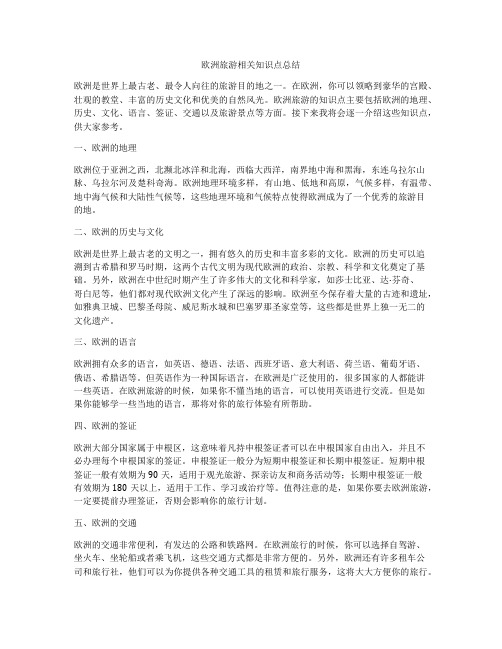欧洲的语言与文化
欧洲的文化差异与交流

欧洲的文化差异与交流欧洲是一个充满多样性的大陆,拥有众多独特的文化。
每个国家和地区都有自己独特的传统、价值观和风俗习惯。
这些文化差异在欧洲各国之间的交流中起着重要的作用。
本文将探讨欧洲的文化差异以及这些差异如何影响着欧洲各国之间的交流。
一、语言差异欧洲拥有众多的语言,每个国家都有自己的官方语言,并且有时会有多种地方方言。
这种语言差异可以成为欧洲文化交流的障碍,因为语言是人们沟通交流的主要工具。
然而,欧洲各国也在积极努力推动语言交流和学习,例如欧洲联盟推行的多语言政策以及各国的语言交流项目,这些努力为减少语言差异提供了一定的帮助。
二、宗教和价值观差异宗教在欧洲文化中扮演着重要的角色。
欧洲各国的宗教信仰和价值观念存在差异,这不仅影响着人们的日常生活,也反映在法律、教育和社会习俗等方面。
例如,南欧国家如意大利和西班牙较为重视天主教信仰,而北欧国家如瑞典和丹麦则更加注重个体自由和平等。
这种宗教和价值观差异在文化交流中可能导致误解和矛盾,但也为人们带来了借鉴和进步的机会。
三、艺术和文学差异欧洲各国有着丰富多样的艺术和文学传统,每个国家都有自己独特的艺术风格和文学经典。
这些差异推动了艺术和文学领域的交流与发展。
例如,法国是著名的文学之国,有着许多享誉世界的作家和文学作品;意大利则以其浪漫的艺术和建筑闻名;荷兰则以画家文化和博物馆闻名。
艺术和文学的交流不仅促进了艺术家和作家的跨国合作,也丰富了欧洲的文化多样性。
四、体育和娱乐差异体育和娱乐也是欧洲文化交流的重要领域。
欧洲各国在体育运动方面有着不同的喜好和特色。
例如,足球是许多欧洲国家最受欢迎的运动,而板球在英国则备受热爱。
每年欧洲各国还举办着各种国际性的体育赛事和音乐节,这为不同国家的人们提供了相互交流和了解的机会。
结语欧洲的文化差异与交流是一个广阔而复杂的话题,本文只是对其进行了简要的概述。
了解和尊重欧洲各国的文化差异是促进欧洲一体化和友好合作的重要基础。
通过促进语言交流、加强宗教和价值观对话、开展艺术和文学合作以及推动体育和娱乐交流,欧洲各国能够更好地理解和欣赏彼此的文化,促进文化多样性的发展和社会进步。
欧洲的语言与翻译多元文化的桥梁

欧洲的语言与翻译多元文化的桥梁语言是人类最重要的交流工具之一,而欧洲作为一个多民族、多语言的大陆,其语言文化的多样性更为突出。
在欧洲,翻译扮演着不可或缺的角色,成为连接不同语言和文化的桥梁。
本文将探讨欧洲的语言多元性、翻译的重要性以及翻译对于多元文化交流的积极影响。
一、欧洲的语言多元性欧洲有众多语言,其中最著名的是印欧语系,包括英语、法语、德语、意大利语等。
此外,还有一些少数语言如芬兰语、匈牙利语、爱尔兰语等。
这些语言的差异性既包括语音、语法、词汇等方面,也体现在不同的文化传统和价值观上。
语言的多元性给欧洲带来了丰富的文化遗产,每一种语言都是一个独特的文化符号。
与此同时,这种多元性也带来了沟通和交流的障碍。
此时,翻译的作用便显得尤为重要。
二、翻译的重要性翻译是将一种语言的文字、口语表达转化为另一种语言的过程。
在欧洲,翻译不仅仅是语言转换,更是文化之间的传递。
通过翻译,不同语言和文化之间的桥梁得以建立,人们可以更好地了解和欣赏其他文化。
翻译不仅仅在文学领域有着广泛的应用,也在商业、政府、学术等领域发挥着重要作用。
在商业活动中,翻译能促进不同国家之间的贸易和交流。
在政府合作中,翻译能帮助不同国家和地区的政府进行有效的沟通。
在学术研究中,翻译则是获取外语资料的主要途径。
三、翻译对多元文化交流的积极影响翻译在促进多元文化交流方面起到了重要作用。
通过翻译,人们能够理解和尊重其他文化,从而加强不同文化之间的相互交流和理解。
首先,翻译有助于消除语言障碍。
通过翻译,人们可以在不同语言环境下进行交流,增进对其他文化的了解。
例如,在欧洲各国的会议中,需要翻译人员将不同语言的发言翻译成共同语言,使代表们能够相互交流。
其次,翻译有助于传播文化和知识。
许多重要的文化传统和学术成果可能因为语言的障碍而得不到全球范围的传播。
通过翻译,这些文化和知识得以跨越语言和地域的限制,实现全球范围的分享。
最后,翻译为多元文化的融合搭建了桥梁。
东欧和南欧的文化差异

东欧和南欧的文化差异东欧和南欧是欧洲大陆上两个地域较为明显的区域,在地理位置、气候环境、历史发展等方面存在着诸多差异。
这些差异也在很大程度上影响了东欧和南欧地区的文化传承与特点。
本文将从语言、宗教、风俗习惯等方面来探讨东欧和南欧文化的差异。
一、语言差异语言作为文化的重要组成部分,是人类交流的工具。
东欧地区的主要国家,如俄罗斯、波兰、乌克兰等,多使用斯拉夫语系,而南欧地区的主要国家,如意大利、西班牙、葡萄牙等,则多使用拉丁语系。
这两种语言系在词汇、发音、语法结构等方面存在较大的差异,反映了东欧和南欧人们思维方式上的不同。
此外,在南欧地区,许多国家拥有独特的方言和口音,比如意大利的托斯卡纳方言、西班牙的安达卢西亚方言等,这进一步丰富了南欧的语言多样性。
相比之下,东欧地区则相对更为统一,方言变化较少。
二、宗教差异宗教信仰也是东欧和南欧地区的重要区别之一。
东欧地区主要信仰东正教,而南欧地区则以天主教为主。
这两个宗教信仰有着各自的仪式和教义,影响着人们的信仰观念、行为准则和价值观。
东正教强调神圣、庄严,注重仪式的严肃性和神秘感。
相比之下,天主教更加注重个体的信仰体验,强调人与神的亲密联系。
这种宗教差异也在东欧和南欧的建筑风格、艺术表现和节日庆典等方面有所体现。
三、饮食差异东欧和南欧的饮食文化也存在差异。
东欧地区的传统饮食以肉类、土豆等为主食,如波兰的锅贴、俄罗斯的罗宋汤等。
而南欧地区则以橄榄油、面包、蔬菜、水果等为主,如意大利的披萨、西班牙的土豆煎饼等。
这种差异主要源自地理环境、农业发展和历史文化的影响。
此外,东欧和南欧地区在饮食习惯和用餐方式上也有所不同。
东欧地区通常注重一日三餐,且以家庭为单位进行集体用餐。
而南欧地区更加强调社交、轻松的用餐氛围,喜欢小吃、小食和家庭聚餐。
四、艺术和文学差异艺术和文学是一个国家和地区文化的展示与传承。
东欧和南欧在艺术和文学方面也存在差异。
东欧的艺术和文学注重表现社会现实、揭示人与命运的关系,多以沉重、悲情的风格为主。
欧洲旅游相关知识点总结

欧洲旅游相关知识点总结欧洲是世界上最古老、最令人向往的旅游目的地之一。
在欧洲,你可以领略到豪华的宫殿、壮观的教堂、丰富的历史文化和优美的自然风光。
欧洲旅游的知识点主要包括欧洲的地理、历史、文化、语言、签证、交通以及旅游景点等方面。
接下来我将会逐一介绍这些知识点,供大家参考。
一、欧洲的地理欧洲位于亚洲之西,北濒北冰洋和北海,西临大西洋,南界地中海和黑海,东连乌拉尔山脉、乌拉尔河及楚科奇海。
欧洲地理环境多样,有山地、低地和高原,气候多样,有温带、地中海气候和大陆性气候等,这些地理环境和气候特点使得欧洲成为了一个优秀的旅游目的地。
二、欧洲的历史与文化欧洲是世界上最古老的文明之一,拥有悠久的历史和丰富多彩的文化。
欧洲的历史可以追溯到古希腊和罗马时期,这两个古代文明为现代欧洲的政治、宗教、科学和文化奠定了基础。
另外,欧洲在中世纪时期产生了许多伟大的文化和科学家,如莎士比亚、达·芬奇、哥白尼等,他们都对现代欧洲文化产生了深远的影响。
欧洲至今保存着大量的古迹和遗址,如雅典卫城、巴黎圣母院、威尼斯水城和巴塞罗那圣家堂等,这些都是世界上独一无二的文化遗产。
三、欧洲的语言欧洲拥有众多的语言,如英语、德语、法语、西班牙语、意大利语、荷兰语、葡萄牙语、俄语、希腊语等。
但英语作为一种国际语言,在欧洲是广泛使用的,很多国家的人都能讲一些英语。
在欧洲旅游的时候,如果你不懂当地的语言,可以使用英语进行交流。
但是如果你能够学一些当地的语言,那将对你的旅行体验有所帮助。
四、欧洲的签证欧洲大部分国家属于申根区,这意味着凡持申根签证者可以在申根国家自由出入,并且不必办理每个申根国家的签证。
申根签证一般分为短期申根签证和长期申根签证。
短期申根签证一般有效期为90天,适用于观光旅游、探亲访友和商务活动等;长期申根签证一般有效期为180天以上,适用于工作、学习或治疗等。
值得注意的是,如果你要去欧洲旅游,一定要提前办理签证,否则会影响你的旅行计划。
欧洲的语言与文化

Chi lingua ha, a Roma va. / Quien lengua ha, a Roma va. / Qui langue a, àRoma va.
In the Hebrew Bible, the name appears as ( ָּב ֶבלBabel), interpreted by Book of Genesis 11:9 to mean "confusion" (viz. of languages), from the verb בלבלbilbél, "to confuse". The Syriac form is Bāwēl, the Arabic form is بابلBābil.
——《圣经·创世纪》11:1-9
Panoramic view over the ancient city of Babylon, located 85 kilometers south of Baghdad.
ִּב ְל ֵּבל
The Greek form Βαβυλών is an adaptation of Babylonian Babili. The Babylonian name as it stood in the 1st millennium BC had been changed from an earlier Babilli in early 2nd millennium BC, interpreted as "gateway of the god" (bāb-ili) by popular etymology. The earlier name Babilla appears to be an adaptation of a non-Semitic source of unknown origin or meaning.
欧洲语言标准

欧洲语言标准欧洲是一个多元文化、多语言的大陆,拥有众多语言和方言。
在这样一个多语言的环境中,语言标准的制定显得尤为重要。
欧洲语言标准的制定不仅涉及到语言的规范化和统一,更关乎到欧洲各国之间的交流和合作。
因此,欧洲语言标准的制定是一项复杂而又重要的任务。
首先,欧洲语言标准的制定需要考虑到各国的语言特点和文化差异。
欧洲大陆上有众多语言,比如英语、法语、德语、意大利语、西班牙语等,每种语言都有其独特的语法规则、词汇和发音特点。
因此,在制定欧洲语言标准时,需要充分考虑到各国语言的特点,尊重各国的语言文化传统,避免对某一种语言进行过分规范化,从而造成文化冲突和语言歧视。
其次,欧洲语言标准的制定需要考虑到语言的实际运用情况。
不同国家和地区对某一种语言的使用方式和语言习惯可能存在差异,因此在制定欧洲语言标准时,需要充分考虑到语言的实际运用情况,尊重各国和地区的语言习惯,避免对语言进行过分的规范化和统一化,从而造成语言使用的不便和困扰。
另外,欧洲语言标准的制定需要考虑到语言技术的发展和应用。
随着科学技术的发展,人们对语言的使用方式和语言技术的需求也在不断变化。
因此,在制定欧洲语言标准时,需要充分考虑到语言技术的发展和应用,积极推动语言技术的创新和应用,为欧洲各国的语言交流和合作提供更加便利和高效的语言技术支持。
总之,欧洲语言标准的制定是一项复杂而又重要的任务,需要充分考虑到各国的语言特点和文化差异,尊重各国的语言文化传统,充分考虑到语言的实际运用情况,避免对语言进行过分的规范化和统一化,积极推动语言技术的发展和应用,为欧洲各国的语言交流和合作提供更加便利和高效的语言技术支持。
希望欧洲各国能够共同努力,制定出更加科学、合理的欧洲语言标准,为欧洲的语言交流和合作提供更好的保障和支持。
欧洲的文化交流与知识传播

欧洲的文化交流与知识传播欧洲,作为一个历史悠久且文化多元的大陆,拥有丰富的文化遗产和知识传统。
在欧洲的历史长河中,文化交流和知识传播扮演了重要的角色,促进了各个国家之间的相互了解与合作。
本文将从历史、语言、艺术和教育等多个方面,阐述欧洲的文化交流与知识传播的重要性和影响。
一、历史的共同纽带欧洲各国历史悠久,各有独特的文化背景。
然而,在不同国家文化的背后,我们可以发现一些共同的纽带。
这种共同纽带是由于欧洲各国在历史上的频繁交流与互动所形成的。
众所周知,欧洲是一个地理相对密集的地区,各国之间的接触和交流较为容易。
通过贸易、战争、婚姻等方式,欧洲不同国家之间的人员、物品和思想得以频繁往来。
这种交流促进了不同文化之间的相互影响和融合,为欧洲大陆的文化多样性打下了坚实的基础。
二、语言的桥梁语言是文化交流和知识传播的重要工具。
欧洲拥有众多的语言,其中英语、法语、德语、西班牙语等被广泛使用和掌握。
这些共同使用的语言成为了欧洲各国之间交流的桥梁,促进了文化和知识的传播。
英语作为全球通用语言,为欧洲国家之间的交流提供了便利。
无论是商务交流、学术合作还是旅游交流,英语的普及使得欧洲各国人民可以更加轻松地进行交流和互动。
此外,欧洲的语言多样性也带来了对其他语言和文化的兴趣与学习,促进了跨文化的交流和理解。
三、艺术的交融欧洲是艺术的发源地之一,各国的艺术作品在欧洲范围内广泛流传。
绘画、雕塑、音乐、建筑等艺术形式都在欧洲范围内得到了独特的发展。
欧洲的艺术作品既反映了各国的独特文化特征,也展现了欧洲文化的共同点。
例如,文艺复兴时期的意大利文化对整个欧洲都有着深远的影响,其艺术作品被广泛学习和模仿。
在欧洲各国之间,艺术作品的交流和展览活动也促进了文化的交流和知识的传播。
四、教育的互补教育是知识传播和文化交流的重要途径。
欧洲各国拥有着高质量的教育体系,各自的教育特色和优势互为补充,为整个欧洲的知识传播做出了贡献。
各国之间的学术合作和交流,不仅加深了彼此对各自领域的了解,也推动了科学研究和学术创新。
欧洲的语言与文化详解

巴别塔 The Tower of Babel
ָּ בבֶל
那时,天下人的口音、言语都是一样。他们往东边迁移 的时候,在示那地遇见一片平原,就住在那里。他们彼 此商量说:“来吧!我们要做砖,把砖烧透了。”他们 就拿砖当石头,又拿石漆当灰泥。他们说:“来吧!我 们要建造一座城和一座塔,塔顶通天,为要传扬我们的 名,免得我们分散在全地。”耶和华降临,要看看世人 建造的城和塔。耶和华说:“看哪,他们成为一样的人 民,都是一样的言语,如今既做起这事来,以后他们所 要做的事就没有不成就的了。我们下去,在那里变乱他 们的口音,使他们的言语彼此不通。”于是耶和华使他 们从那里分散在全地上;他们就停了,不造那城了。因 为耶和华在那里变乱了人的言语,使众人分散在全地上, 所以那城名叫巴别(就是变乱的意思)。 ——《圣经· 创世纪》11:1-9
The Tower of Babel (1563) Pieter Brueghel the Elder, oil langues indo-europé ennes
The Indo-European languages
The Indo-European languages comprise a family of several hundred related languages and dialects, including most of the major languages of Europe, as well as many spoken in the Indian subcontinent (South Asia), the Iranian plateau (Southwest Asia), and Central Asia. Contemporary languages in this family with more than 100 million native speakers each include English, Hindi, Spanish, Portuguese, Bengali, Russian, French and German. Numerous national or minority languages with fewer than 100 million native speakers also exist. Indo-European has the largest numbers of speakers of the recognised families of languages in the world today, with its languages spoken by approximately 3 billion native speakers. The Indo-Iranian languages form the largest sub-branch of Indo-European.
欧洲的文化多样性语言与传统的交融

欧洲的文化多样性语言与传统的交融欧洲的文化多样性:语言与传统的交融欧洲是一个拥有丰富多样的文化遗产的大陆。
无论是语言还是传统,欧洲各国间都存在着深刻的交融和多样性。
本文将探讨欧洲各国在语言和传统方面的特点,并介绍它们之间的交流和融合。
一、语言多样性欧洲是世界上语言种类最为丰富的地区之一。
根据统计,欧洲共有超过200种活跃使用的语言。
这些语言可以分为几个主要语系,如日耳曼语系、拉丁语系、斯拉夫语系等。
1. 日耳曼语系日耳曼语系包括德语、英语、荷兰语等语言。
其中,德语是最为广泛使用的语言之一,被认为是欧洲强国的代表。
英语作为全球通用语言,在欧洲也有广泛的使用。
2. 拉丁语系拉丁语系中最有影响力的语言是法语、意大利语和西班牙语。
这些语言主要分布在南欧和西欧地区,并且对其他国家产生了深远的影响。
3. 斯拉夫语系斯拉夫语系主要包括俄语、波兰语、捷克语等。
这些语言主要存在于中欧和东欧国家,该语系是欧洲最为广泛分布的语言之一。
除了上述主要语系外,欧洲还有许多少数民族语言,如芬兰语、匈牙利语等,这些语言在特定地区也有一定的传承和使用。
二、传统的交融欧洲的文化传统源远流长,且各个国家都有独特的传统价值观和习俗。
然而,由于地理和历史的原因,传统在欧洲国家间发生了交融和融合。
1. 宗教和宗教节日欧洲国家的宗教背景不同,基督教、天主教和东正教是主要的宗教信仰。
因此,许多宗教节日在欧洲各国都有庆祝活动。
例如,圣诞节、复活节和圣帕特里克节都是广受欢迎的节日,并且在不同国家都有特色庆祝方式。
2. 饮食文化欧洲各国的饮食文化也存在着相互的影响和交流。
意大利的比萨饼、法国的红酒、西班牙的火腿等都成为了世界范围内的美食代表。
在欧洲旅行,你可以品尝到各种不同风味的美食,感受不同文化的烹饪传统。
3. 艺术和建筑欧洲是世界艺术和建筑的重要中心之一。
文艺复兴时期的意大利艺术和巴洛克风格的法国建筑都对整个欧洲产生了深远的影响。
这些艺术和建筑风格的传播,使得欧洲各国在艺术领域形成了相互的交流和启发。
东欧和西欧的文化差异

东欧和西欧的文化差异东欧和西欧是两个不同的地理和文化区域,虽然它们都属于欧洲大陆,但却存在着显著的文化差异。
本文将探讨东欧和西欧在语言、宗教、风俗习惯、饮食和艺术等方面的差异。
一、语言差异东欧和西欧在语言方面存在明显差异。
西欧主要以英语、法语、德语、意大利语和西班牙语为主要语言,而东欧则以俄语、波兰语、捷克语、匈牙利语和罗马尼亚语为主要语言。
这些语言差异反映了不同的历史和文化背景。
语言差异使得东欧和西欧的人们在沟通上存在一定的障碍。
然而,随着全球化的进程,英语的普及使得东欧和西欧的人们更容易进行交流。
二、宗教差异东欧和西欧在宗教信仰上也存在显著差异。
西欧主要信奉天主教,东欧则主要信仰东正教。
这两个宗教信仰系统代表了两个地区不同的历史发展和文化传统。
宗教差异在东欧和西欧的社会和文化生活中产生了深远的影响。
例如,在东欧国家,宗教仍然扮演着重要的角色,教堂在人们的日常生活中具有重要地位;而在西欧,宗教的影响力逐渐减弱,社会逐渐世俗化。
三、风俗习惯差异东欧和西欧在风俗习惯方面也存在一定的差异。
东欧国家注重家庭和社区的联系,家庭在东欧文化中具有重要的地位。
家人之间的团聚和互助是东欧文化的核心价值。
而在西欧,个人独立和自由的观念更加强烈,注重个人隐私和自主性。
此外,东欧和西欧在节日庆祝方式上也存在差异。
东欧的节日常常与宗教信仰相关,如复活节和圣诞节;而西欧的节日则更加多元化,包括国庆节、万圣节等。
四、饮食差异东欧和西欧在饮食方面也有一些不同。
东欧的饮食以肉类和土豆为主,如俄罗斯的酱牛肉和波兰的波兰香肠。
而西欧的饮食则更加注重谷物、奶制品和海鲜,如法国的巴黎面包和西班牙的海鲜饭。
此外,东欧和西欧在用餐习惯上也存在差异。
在东欧,用餐时通常较为隆重,家人聚餐是重要的社交活动。
而在西欧,午餐通常较为简便,晚餐则更注重家庭聚会和社交活动。
五、艺术差异东欧和西欧的艺术表现也存在差异。
东欧的艺术更注重象征主义和宗教观念,表现出一种神秘和浪漫的氛围。
欧洲语言标准

欧洲语言标准欧洲是一个多民族、多语言的大陆,拥有丰富多彩的语言文化。
在欧洲,有着多种语言标准,这些标准在不同国家和地区有着不同的影响和地位。
本文将就欧洲语言标准进行探讨,以便更好地了解欧洲语言多样性的特点。
首先,欧洲语言标准主要由欧盟成员国的官方语言构成。
欧盟官方语言共有24种,其中包括英语、法语、德语、西班牙语、意大利语等。
这些语言在欧盟内部以及国际交流中具有重要地位,是欧盟成员国的官方语言,也是欧盟机构的工作语言。
其次,欧洲语言标准还包括一些少数民族语言的标准化工作。
欧洲有着众多少数民族,其语言文化丰富多样。
为了保护和传承这些少数民族语言,欧盟成员国和地区进行了一系列的标准化工作,推动这些语言的规范化和发展,以保护少数民族语言的多样性和独特性。
此外,欧洲语言标准还涉及到地区性语言的规范和推广。
在欧洲的一些国家和地区,还存在着一些地区性语言,如加泰罗尼亚语、威尔士语、布列塔尼语等。
这些地区性语言在当地具有重要地位,为了保护和传承这些语言,相关国家和地区也进行了一系列的标准化工作,推动这些语言的规范化和发展。
总的来说,欧洲语言标准是一个复杂而多样的系统,涵盖了官方语言、少数民族语言和地区性语言。
这些语言标准的形成和发展,既反映了欧洲多元文化的特点,也为欧洲各国和地区的语言文化传承和发展提供了重要的保障。
在今天的全球化背景下,欧洲语言标准的重要性日益凸显。
欧洲各国和地区之间的交流合作日益频繁,语言交流成为了交流合作的重要工具。
因此,欧洲语言标准的统一和规范化工作显得尤为重要,这不仅有利于欧洲各国和地区之间的交流合作,也有利于欧洲语言文化的传承和发展。
总之,欧洲语言标准是欧洲语言多样性的重要组成部分,涵盖了官方语言、少数民族语言和地区性语言。
这些语言标准的形成和发展,既反映了欧洲多元文化的特点,也为欧洲各国和地区的语言文化传承和发展提供了重要的保障。
在今天的全球化背景下,欧洲语言标准的统一和规范化工作显得尤为重要,这将有利于欧洲各国和地区之间的交流合作,也有利于欧洲语言文化的传承和发展。
欧洲的语言与多元文化

欧洲的语言与多元文化在欧洲大陆的辽阔土地上,存在着丰富多样的语言和多元文化。
这个地区有着悠久的历史和复杂的人类迁徙背景,因此形成了一个语言纷呈、文化多样的社会。
本文将探讨欧洲的语言多样性以及相关的多元文化特点。
欧洲是一个拥有众多国家和民族的大陆,共有24个官方语言和超过200种地方语言。
其中,最广泛使用的官方语言是英语、法语、德语、意大利语和西班牙语等,这些语言在欧洲范围内通行。
此外,一些地区使用非官方语言,如加泰罗尼亚语、威尔士语等。
每种语言都有其独特的特点和使用范围。
多年来,欧洲各地的语言和文化之间形成了复杂的关系,这源于历史上的政治、经济和人口迁移等因素。
在欧洲东部,斯拉夫语族是主要的语言家族,包括俄语、波兰语、捷克语和保加利亚语等。
在南部,有许多罗曼语族语言,如罗马尼亚语和葡萄牙语。
此外,北部和中部地区则有日耳曼语族、凯尔特语族等语言。
欧洲的多元文化是其语言多样性的反映。
不同国家和地区的文化特点广泛存在,每个地方都有着自己独特的传统、价值观和生活方式。
尽管欧洲的大部分地区受到了西方文化的影响,但每个国家和地区还是保留了自身的文化传统。
例如,意大利以其丰富的美食文化、时尚和艺术闻名于世;德国则以啤酒节、室内设计和汽车制造业等领域独树一帜;法国则以其浪漫主义的文化、时尚和美食闻名于世。
在欧洲,语言和文化之间存在相互影响和交流。
随着人们的语言交流和文化交融,欧洲形成了一个多元文化的社会。
例如,在欧盟成员国之间,有许多欧洲共同语言和文化项目,这有助于加深彼此的了解和团结。
另外,欧洲的语言和文化的多样性也吸引着来自其他地区的人们前来交流、学习和工作。
然而,由于多种语言的存在,欧洲也面临着一些挑战。
语言障碍成为欧洲内部和外部交流中的一个难题。
为了促进交流和理解,欧洲联盟实行了多语言政策,使得欧洲各国的人民都能使用自己的母语与其他成员国进行交流。
此外,一些语言也得到了特殊保护,以保持语言和文化的多样性。
欧洲语言种类的文化底蕴

标题:欧洲语言种类的文化底蕴欧洲,这个地理和文化交汇的独特区域,孕育了丰富多彩的语言种类。
这些语言不仅是沟通的工具,更是承载了深厚的历史和文化底蕴。
它们在欧洲的各个角落繁衍生息,形成了一道独特的语言文化风景线。
一、拉丁语的传承与影响拉丁语是欧洲语言种类的源头,起源于古罗马帝国时期的拉丁语族。
拉丁语作为欧洲的主要商业用语,在中世纪时期广泛传播,影响了欧洲大部分地区的语言。
它不仅是意大利语、西班牙语、葡萄牙语和法语等罗曼语族的基础,也是现代英语的重要来源之一。
拉丁语的严谨、精确和规范的特点,使得它成为许多欧洲国家教育体系中的重要组成部分,为欧洲文化的发展奠定了基础。
二、民族语言的多样性欧洲各国的民族语言也是其文化底蕴的重要组成部分。
从北欧的瑞典语、芬兰语,到南欧的希腊语、意大利语、西班牙语和葡萄牙语,再到东欧的波兰语和捷克语,这些语言各自拥有独特的语音、词汇和语法结构,反映了各自民族的历史、信仰、风俗和艺术。
这些语言不仅丰富了欧洲的语言文化,也为各国的文化交流提供了桥梁。
三、语言与历史的关系欧洲语言的发展与欧洲历史紧密相连。
从古希腊罗马文化的辉煌,到中世纪基督教文化的繁荣,再到文艺复兴时期的辉煌成就,每个阶段都有其独特的语言表现形式。
例如,古希腊语的演变形成了现代的德语、拉丁语的演变影响了法语和意大利语的形成,而中世纪英语的演变则与当时的社会、政治和经济环境密切相关。
这些语言的变化和发展,反映了欧洲历史的发展和变迁。
四、语言与文学的关系欧洲文学的发展与语言息息相关。
从古希腊的神话故事,到中世纪的骑士传奇,再到文艺复兴时期的文学巨匠如莎士比亚、歌德的作品,这些文学作品都是通过不同的语言形式表达出来的。
这些文学作品不仅丰富了欧洲的文化遗产,也为后人提供了了解欧洲历史和文化的重要途径。
此外,许多文学作品中的语言形式和表达方式也在一定程度上影响了欧洲语言的发展和变化。
五、语言与宗教的关系宗教在欧洲历史和文化中扮演了重要角色,对欧洲语言的影响也不可忽视。
欧洲简史欧洲的语言与语言保护

欧洲简史欧洲的语言与语言保护欧洲简史:欧洲的语言与语言保护欧洲是一个历史悠久、多元文化的大陆,拥有众多不同的语言。
这些语言的存在既是欧洲文化的丰富多彩之处,也是各个国家和地区的独特之处。
然而,随着全球化的发展和国际交流的增加,欧洲的语言面临着一些挑战。
本文将探讨欧洲语言的多样性以及语言保护的重要性。
一、欧洲的语言多样性欧洲是世界上语言种类最丰富的地区之一。
根据欧洲语言组织的统计数据,欧洲目前有超过200种不同的语言,其中包括官方语言、地区语言、少数民族语言等。
例如,英语、法语、德语、西班牙语、意大利语等是欧洲国家的官方语言,而加泰罗尼亚语、威尔士语、巴斯克语等是一些地区的官方语言。
此外,一些少数民族语言如拉普兰语、斯洛文尼亚语等也在欧洲境内得到广泛使用。
这种语言多样性反映了欧洲的历史和文化差异。
欧洲的各个国家和地区有着不同的历史背景和文化传统,因此语言也随之形成和发展。
这些语言不仅是人们交流的工具,更是一种文化和身份的象征。
二、语言的重要性和挑战语言在社会和文化中具有举足轻重的地位。
语言不仅仅是进行沟通交流的工具,更是人们思想、价值观和认同感的表达方式。
每种语言都有其独特的词汇、语法和语音特点,反映了其所属社群的独特视角和文化认同。
然而,随着全球化的进程,来自不同国家和地区的人们交流和交往的机会增多,使用全球通用语言(如英语)的趋势也在加强。
这给欧洲的语言多样性带来了一些挑战。
一方面,全球通用语言的使用使得一些小语种的使用者逐渐减少,这可能导致这些语言逐渐衰退甚至消亡。
例如,在一些欧洲国家,像爱尔兰语和马耳他语这样的地区语言使用者稀少,并且正面临着流利使用者的减少的威胁。
另一方面,使用全球通用语言可能导致文化传统和身份认同的丧失。
语言是文化的重要组成部分,它传承了一个民族的价值观、习俗和历史。
如果人们只使用全球通用语言,可能会导致对本土文化的忽视和遗忘。
三、语言保护的重要性面对语言多样性的重要性和挑战,欧洲各国开始采取措施保护和促进本土语言的使用和发展。
欧洲简史欧洲的语言与文化交流

欧洲简史欧洲的语言与文化交流欧洲简史 - 欧洲的语言与文化交流欧洲大陆作为一个多元文化的地区,拥有众多国家、民族和语言。
在漫长的历史过程中,欧洲的各个地区之间进行着频繁的语言与文化交流,这不仅丰富了欧洲的文化多样性,也对整个世界产生了深远的影响。
本文将简要介绍欧洲的语言与文化交流的历史演变和重要影响。
一、古代交流:希腊与罗马文明公元前8世纪,希腊城邦的兴起标志着欧洲的第一次重要的语言与文化交流。
希腊语逐渐成为古代希腊城邦之间的交流工具,同时也是文化的传承媒介。
希腊语的文字系统以及哲学、政治、文学等方面的成就对整个欧洲产生了深远的影响。
随着希腊文化的传播,罗马帝国兴起,拉丁语也成为了广泛使用的欧洲语言之一。
罗马的征服使得拉丁语成为了欧洲大陆的交流工具,同时也推动了拉丁文化的传播。
诸如法律、建筑和艺术等方面的罗马文明为后来的欧洲语言和文化奠定了基础。
二、中世纪交流:宗教与贸易在中世纪,宗教起到了重要的桥梁作用。
基督教的传播使得拉丁语成为教会的官方语言,并促使修道院和大教堂成为文化和知识的中心。
在修道院中,僧侣们利用拉丁语阅读和复制古代文化的著作,保留了许多古代知识,并将其传播到整个欧洲。
与宗教并行的是贸易,贸易为各个地区的交流提供了机会。
在贸易的活动中,商人们使用的是他们自己的母语,这加强了各个国家和地区之间的联系。
同时,贸易也带来了东方文化的输入,如阿拉伯数学、医学和哲学成就的传入。
三、文艺复兴:人文主义与印刷术文艺复兴是欧洲历史上又一个重要的时期,也是语言与文化交流的重要时期。
人文主义的兴起强调个人的独立思考和人类的价值,这推动了对古希腊和古罗马文化的研究和传承。
人文主义者们利用拉丁语阅读古代文献,推动了教育的发展和语言的研究。
另一个重要的技术创新是印刷术的发明,它使得书籍的复制和传播变得更加快捷和广泛。
印刷术的出现促进了各个地区之间的文化交流,拉丁文书籍成为人们学习和研究的重要工具。
此外,印刷术还推动了各个地区本土语言文字的发展和使用。
欧洲文化多样性语言与传统的丰富

欧洲文化多样性语言与传统的丰富欧洲是一个拥有丰富多样的文化和传统的大陆。
在这片土地上,有许多不同的民族、语言和宗教,这使得欧洲成为一个充满文化多样性的地区。
本文将探讨欧洲文化多样性对语言和传统的丰富影响。
1. 语言的多样性欧洲是一个有着众多语言的地区。
据统计,欧洲共有24个官方语言,并且还有被广泛使用的地方语言和少数民族语言。
这些语言包括英语、法语、德语、意大利语、西班牙语等。
这些语言的存在丰富了欧洲的语言文化,同时也为欧洲的人们提供了更多的交流和交流的机会。
语言的多样性使得欧洲成为一个充满魅力和挑战的地区。
人们可以通过学习不同的语言来了解不同文化背景的人们,同时也能够更好地理解和欣赏不同国家和民族的文学、音乐、电影等具有地方特色的艺术作品。
而对于欧洲的居民来说,掌握多种语言不仅有助于他们的工作和生活,还能够提升他们的国际竞争力。
2. 传统的丰富欧洲拥有丰富多样的传统,每个国家和民族都有自己独特的文化遗产。
比如,英国的交响乐、法国的时装、德国的啤酒节、西班牙的斗牛等都是各国独有的传统活动。
这些传统不仅丰富了欧洲的文化内涵,同时也为游客提供了更多的旅游和体验的机会。
传统文化的保存和传承对于保护欧洲的多样性非常重要。
欧洲各国政府和非政府机构都致力于保护和传承自己的传统文化。
他们通过设立传统艺术学校、举办传统节日和活动、修复和保护文化遗址等方式来确保传统文化得以延续。
这样,无论是欧洲的居民还是游客,都能够深入了解和体验到欧洲各地的传统文化的魅力。
3. 文化多样性的挑战虽然欧洲的文化多样性给人们带来了许多机遇和乐趣,但同时也面临一些挑战。
语言障碍和文化差异是最主要的挑战之一。
不同国家和民族之间存在着不同的语言和文化习惯,这使得沟通和理解变得更加困难。
此外,一些少数民族的语言和传统正面临着消失的威胁,这对于维护欧洲文化多样性造成了威胁。
为了克服这些挑战,许多欧洲国家和机构采取了积极的措施。
他们鼓励各国之间的文化交流和合作,推动多语言教育和学习,保护和传承弱势语言和传统,以确保欧洲的文化多样性能够得以持续。
中国和欧洲国家的语言文化有何异同?

中国和欧洲国家的语言文化有何异同?随着全球化的加速,各国之间的交流越来越频繁,然而,语言这一文化的核心组成部分不同国家之间的异同依然是存在的。
而作为世界上最为古老的文字系统之一,中文对于中国人民的日常生活有着极其重要的影响。
那么,与之对比的欧洲国家的语言文化又是如何的呢?接下来将从三个方向进行详细探讨。
1. 语音语调和发音中文和欧洲语言之间的差异在语音和语调方面表现得特别明显。
整体而言,中文的语音和语调比较平坦,而欧洲语言的语音和语调则比较丰富和变化多端。
例如,在英语中,同一个单词的不同说法可能会给人带来不同的语义信息,而中文则很少有这种情况。
此外,在语音和语调方面,欧洲语言的发音具有一定的固定规则,而中文则遇到特殊情况时常常会出现个人化的发音,这也就造成了普通话的规范化普及的难度。
2. 语法联结和表达方式中文和欧洲语言在语法联结和表达方式上也有很大的差异。
相比欧洲语言的语法结构,中文注重构词和造句的内在意义的联结。
中文的表达也更加简洁、直观。
以英语为例,常常需要借助虚词来表现出语义的变化,而中文的话则让人觉得更加自然。
然而,中文语法结构和其他欧洲语言的结构不易对应,对于欧洲人来说学习中文的语法可以说是一个不小的挑战。
3. 文化和使用场景语言作为文化的载体,当然是也包含文化方面的差异。
中文和欧洲语言文化背景的差异也反映在了日常使用场景上。
中国人一般在日常交流中更倾向于使用直白、直接、明了的夸张形容。
这种形容与欧洲人的卫生、道德、文化等方面的差异和习惯有很大关系。
除此之外,在许多其他语言中,如法语、西班牙语中,也存在很多与中文不太一样的表达方式。
综上所述,中国和欧洲国家的语言文化确实存在一定的差距,这些差距很大程度上还与地域文化、历史习惯、社会制度等方面的差异有关。
无论是中文还是欧洲语言,它们都是各自文化的载体和表现形式。
学习和研究不同语言的文化和差异,可以增进对世界各地文化的了解和理解,促进不同文化之间的交流和融合。
欧洲的文化交流与互动

欧洲的文化交流与互动欧洲作为一个多民族、多文化的大陆,其文化交流与互动一直以来都非常活跃。
这种交流与互动不仅体现在艺术、音乐、文学等领域,还涉及到宗教、语言、建筑等方面。
本文将探讨欧洲的文化交流与互动,并分析其背后的影响与意义。
一、艺术与文学的交流与互动艺术与文学一直被视为文化的灵魂,欧洲各国之间的艺术与文学交流与互动非常频繁。
从文艺复兴时期开始,欧洲艺术家和文学家之间的互动逐渐加强。
例如,达·芬奇和米开朗基罗等艺术家在不同国家进行创作和交流,互相影响,共同推动了文艺复兴的进程。
同时,欧洲的文学交流也非常活跃。
文学作品通过翻译被传播到不同的国家和地区,比如莎士比亚的作品在欧洲各国被广泛阅读和演出。
这种跨国的文学交流有助于不同国家之间的相互理解和文化融合。
二、宗教的交流与互动宗教在欧洲的文化交流与互动中扮演着重要的角色。
在欧洲历史上,犹太教、基督教和伊斯兰教三大宗教的交流与互动非常显著。
例如,中世纪的十字军东征使得基督教和伊斯兰教之间发生了多次冲突和交流。
同时,犹太教在欧洲也有着自己的特殊地位,犹太人在不同国家之间的迁移和交流也促进了不同宗教之间的互动。
宗教交流与互动对于欧洲的文化发展有着深远的影响。
不同宗教之间的交流使得欧洲的文化更加多元化,也带来了不同宗教信仰的融合与共存。
三、语言的交流与互动欧洲拥有众多的语言,语言的交流与互动也是欧洲文化交流的重要组成部分。
欧洲的语言交流早在古希腊和罗马时期就已经开始。
拉丁语作为通用语言在罗马帝国范围内广泛使用,这促进了不同地区之间的交流与互动。
同时,欧洲的语言翻译工作也非常发达。
各国之间的文学作品、科学著作以及政府文件等被广泛翻译成不同的语言,促进了不同国家之间的沟通和交流。
四、建筑与城市规划的交流与互动欧洲的建筑与城市规划也是文化交流与互动的重要方面。
不同国家的建筑风格和城市规划理念相互影响,形成了欧洲独特的城市风貌。
例如,哥特式建筑风格在中世纪时期盛行于法国,而后传播到其他欧洲国家,成为当时建筑风格的主导。
欧洲的文化交流

欧洲的文化交流欧洲被誉为世界上文化交流最为频繁、多元的地区之一。
自古以来,欧洲大陆上的各个国家和地区就因其丰富多样的文化而吸引了无数人的目光。
本文将就欧洲的文化交流进行探讨,从历史、艺术、语言等多个方面解析欧洲文化的独特魅力。
一、历史的交错与交流欧洲作为一个历史悠久的大陆,几千年来历经战争、迁徙和政治变革。
通过这些历史事件,欧洲各国间进行了大量的文化交流。
例如,古希腊文化是欧洲文化的重要组成部分。
在希腊城邦兴盛的时期,思想家、艺术家和学者们聚集在一起,形成了具有深邃思想和精湛艺术的希腊文化。
另一个重要的文化交流源头是罗马帝国。
罗马城市的建立,为欧洲修建了一条连接东西方的文化之路。
罗马法律、建筑、艺术等方面的传播,不仅对当时的欧洲有着深远影响,也为整个文明史埋下了伏笔。
欧洲的文化交流还得益于中世纪时期的十字军东征。
各个欧洲国家的骑士和军队在前往耶路撒冷和其他中东地区的过程中,接触到了东方文化。
回国后,他们将所见所闻带回国内,使得欧洲的文化更加多元化。
二、艺术的交融与碰撞欧洲在艺术领域的交流可以追溯到古代。
古希腊的雕塑艺术和罗马的壁画艺术为欧洲的艺术发展奠定了基础。
中世纪时期的哥特式建筑风格,将宗教和艺术融为一体,成为当时欧洲最受追捧的艺术形式。
文艺复兴时期,欧洲艺术达到了巅峰。
意大利艺术家们的杰作,如达芬奇的《蒙娜丽莎》和米开朗基罗的《创造亚当》等,成为世人所瞩目的艺术奇迹。
这些艺术作品不仅受到当时欧洲各国的追捧,也为后世的艺术创作者提供了灵感。
十九世纪后期,印象派艺术家们的诞生,对欧洲艺术产生了深远的影响。
他们以光影变幻、色彩互补为特点,推动了艺术表现形式的革新,为欧洲的艺术交流注入了新的活力。
三、语言的多样与融合欧洲地区的语言非常多样,每个国家和地区都有其独特的语言系统。
然而,在欧洲的文化交流过程中,语言的多样性并没有成为障碍,反而促进了语言的融合和跨国交流。
拉丁语是欧洲文化交流的重要媒介之一。
- 1、下载文档前请自行甄别文档内容的完整性,平台不提供额外的编辑、内容补充、找答案等附加服务。
- 2、"仅部分预览"的文档,不可在线预览部分如存在完整性等问题,可反馈申请退款(可完整预览的文档不适用该条件!)。
- 3、如文档侵犯您的权益,请联系客服反馈,我们会尽快为您处理(人工客服工作时间:9:00-18:30)。
The expansion of the Germanic tribes 750 BC – AD 1
(after the Penguin Atlas of World History 1988): Red: Settlements before 750BC; Brown: New settlements until 500BC Yellow: New settlements until 250BC; Green: New settlements until AD 1
Языки и Куљтура в Эвропе
Γ λωσσαι και Kαλλιεργειαι Eυρωπων
Linguae et Cultura Europae
一、西方文化与语言学习
语言学习的魅力来自唱歌剧用意大利语;读诗歌用俄语;与上帝交谈用西班 牙语;与情人私语用法语;思考哲学用德语;要饭用英 语。(欧洲谚语) 生活在世上而只会说一种语言,这有点象生活在一座巨 大无比的建筑物中而只呆在一个房间里。懂得一种以上 语言的人会发现,展现在他们面前的是另一种迷人的新 景象,这不仅为他们提供了实际运用这些语言的机会, 还可以满足求知欲,以及使他们感受到另一种文化的观 点和背景去观察世界的魅力。(肯尼斯· 卡兹纳) Chi lingua ha, a Roma va. / Quien lengua ha, a Roma va. / Qui langue a, àRoma va. 谁能说罗马的语言,谁就能去罗马。 (欧洲谚语)
IndoEurop ean Lingui stic Tree
1. 斯拉夫语
东斯拉夫语:俄语、乌克兰语 白俄罗斯语 西斯拉夫语:波兰语、捷克语 斯洛伐克语 南斯拉夫语:保加利亚语、马其顿语 克罗地亚-塞尔维亚语 斯洛文尼亚语
Distribution of slavic languages
2. 日耳曼语系
The Tower of Babel (1563) Pieter Brueghel the Elder, oil on board
二、欧洲语言的分类
Les langues indo-europé ennes
The Indo-European languages
The Indo-European languages comprise a family of several hundred related languages and dialects, including most of the major languages of Europe, as well as many spoken in the Indian subcontinent (South Asia), the Iranian plateau (Southwest Asia), and Central Asia. Contemporary languages in this family with more than 100 million native speakers each include English, Hindi, Spanish, Portuguese, Bengali, Russian, French and German. Numerous national or minority languages with fewer than 100 million native speakers also exist. Indo-European has the largest numbers of speakers of the recognised families of languages in the world today, with its languages spoken by approximately 3 billion native speakers. The Indo-Iranian languages form the largest sub-branch of Indo-European.
巴别塔 The Tower of Babel
בל ֶב ָּ
那时,天下人的口音、言语都是一样。他们往东边迁移 的时候,在示那地遇见一片平原,就住在那里。他们彼 此商量说:“来吧!我们要做砖,把砖烧透了。”他们 就拿砖当石头,又拿石漆当灰泥。他们说:“来吧!我 们要建造一座城和一座塔,塔顶通天,为要传扬我们的 名,免得我们分散在全地。”耶和华降临,要看看世人 建造的城和塔。耶和华说:“看哪,他们成为一样的人 民,都是一样的言语,如今既做起这事来,以后他们所 要做的事就没有不成就的了。我们下去,在那里变乱他 们的口音,使他们的言语彼此不通。”于是耶和华使他 们从那里分散在全地上;他们就停了,不造那城了。因 为耶和华在那里变乱了人的言语,使众人分散在全地上, 所以那城名叫巴别(就是变乱的意思)。 ——《圣经· 创世纪》11:1-9
Kurgan hypothesis: South Russia as the urheimat of Indo-European peoples.
Map of Indo European migrations from ca. 4000 to 1000 BC according to the Kurgan model. The Anatolian migration (indicated with a dotted arrow) could have taken place either across the Caucasus or across the Balkans. The purple area corresponds to the assumed Urheimat (Samara culture, Sredny Stog culture). The red area corresponds to the area which may have been settled by Indo-Europeanspeaking peoples up to ca. 2500 BC, and the orange area by 1000 BC.
The Germanic languages in Europe
Dutch (Low Franconian, West Germanic) Low German (West Germanic) Central German (High German, West Germanic) Upper German (High German, West Germanic) Anglic (Anglo-Frisian, West Germanic) Frisian (Anglo-Frisian, West Germanic) East Scandinavian West Scandinavian Line dividing the North and West Germanic languages
3. 拉丁语系
意大利语 法语 西班牙语 葡萄牙语 罗马尼亚语 Proportion of the 690 million native Romance language speakers of each language
Romance languages
Group of related languages derived from Latin, with nearly 920 million native speakers. The major Romance languages — French, Spanish, Portuguese, Italian, and Romanian — are national languages. French is probably the most internationally significant, but Spanish, the official language of 19 American countries and Spain and Equatorial Guinea, has the most speakers. Languages spoken in smaller areas include Catalan, Occitan, Sardinian, and Rhaeto-Romance. The Romance languages began as dialects of Vulgar Latin, which spread during the Roman occupation of Italy, the Iberian Peninsula, Gaul, and the Balkans and developed into separate languages in the 5th– 9th centuries. Later, European colonial and commercial contacts spread them to the Americas, Africa, and Asia.
语言学习的魅力
By words the mind is winged. ----Aristophanes Language is the dress of ideas. 语言是思想的外衣。 (Samuel Johnson) Apprendre une langue, c’est vivre de nouveau.学习一种外 语,是一次新生。(法国) Veritas simplex oratio est. 真理的言语是简单的。 Die Sprache ist das Haus des Seins.语言是存在的家园。 (海得格尔) Wer fremde Sprachen nicht kennt, weiss nicht von seiner eigenen. 不懂外语的人,对自己的母语会一无所知。(Goethe) Eine Fremdsprache ist eine Waffe im Kampf des Lebens. 外语是人生斗争的武器。 (马克思)
